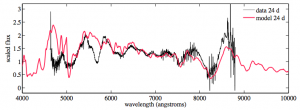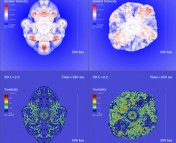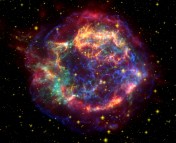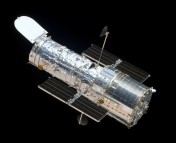TITLE: Rapidly Fading Supernovae from Massive Star Explosions
AUTHORS: Io K. W. Kleiser, Dan Kasen
FIRST AUTHOR’S INSTITUTION: Caltech
As more transient surveys have come online, the supernova zoo has grown more and more populated. From the original Type Ia/b/c and Type IIn/p/l designations, many new categories and subcategories have sprung up as we find transients that don’t fit neatly in any known box. One such group of outliers is the rapidly fading supernovae (RFSNe), transients that rise to luminosities comparable to typical core-collapse supernovae but fade much quicker than expected and lack the characteristic lightcurve tail indicating radioactive decay. Most models proposed to explain this class of transients invoke either a failed or partial explosion, such as the burning of a helium shell on a C/O white dwarf or a very weak core-collapse. These models explain the lack of heavy radioactive elements by invoking either minimal production of ejecta (thus making no heavy elements) or large amounts of fallback onto a central object (thus removing those elements). In this paper the authors present a model to explain one such transient, SN2010X. This model posits instead a standard core-collapse explosion of a standard Type Ib/Ic supernova progenitor, but one that produces very little radioactivity and instead exhibits a light curve governed by oxygen recombination.
Based on the oxygen lines present in SN2010X’s spectra, the authors estimate that around 1 solar mass of oxygen was ejected in the explosion. This runs counter to the expectations of RFSNe models that give very low overall ejecta masses. A rapid decline in luminosity in a supernova is much easier to reconcile with a low ejecta mass, since if there is not much material surrounding the explosion, energy will take much less time to diffuse out and escape. A large amount of ejecta, conversely, will trap the energy for longer and thus create a slower decline.

Observed spectrum of SN2010X at 24 days compared with synthetic spectrum obtained from radiation transfer modeling of a standard core-collapse explosion with no radioactivity and highly oxygen-rich ejecta.
In order to reconcile these two effects, the authors model a simple explosion in the 1D radiative transfer code SEDONA. They show that, if the bulk of the ejecta is composed of oxygen, its sharp drop in opacity due to recombination around T ~ 6000 K allows the radiation to escape quickly and can produce a rapid drop in luminosity (a mixture rich in heavy nickel-iron, by contrast, will remain opaque well down to T ~ 3000 K). In this case the lightcurve is powered by the energy of the initial shockwave being released as the ejecta recombines, rather than by the decay of radioactive elements, thus leaving no characteristic radioactive decay tail. This scenario can reproduce the core-collapse-like spectrum of SN2010X while still explaining its rapid decline.
However a few problems remain. The highly oxygen-rich ejecta requires a progenitor that has been stripped of its hydrogen and helium envelopes, such as a Wolf-Rayet star, but fitting the lightcurve requires a stellar radius much larger than any known stripped-envelope stars. Thus either the star must be puffed up by some mechanism, or the light must instead be emitted from a circumstellar shell of previously ejected material. Hopefully as more examples of these transients are recorded we can get a better handle on their behavior, and start exploring the many different ways a star can die.




